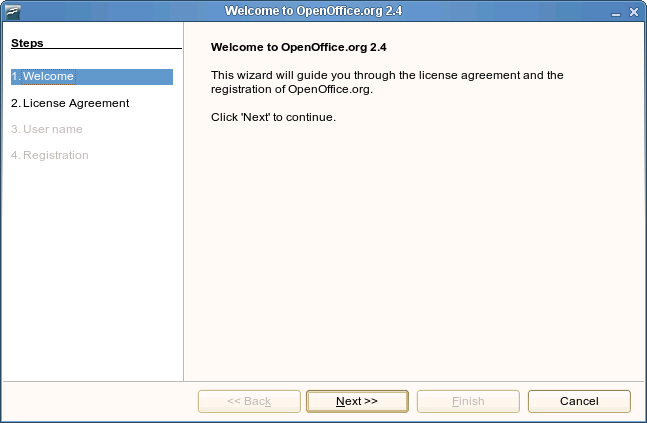User Experience/NewUser
Contents
Intro
When a new user installs OOo, he is asked at first start of the program to register the product.
This process has major disadvantages:
- although OOo is mentioned as a 'free program, the user has to register it
- any useful details/help are missing
- the ensuing survey is long and offers little insight into relevant user-activities
UX-Problems
Dialog
At present the dialog works in a very non-User friendly manner.
The presentation needs to be more visually attractive and the language more conversational and friendlier.
A good phrase to convey this is "One time setup."
The User is asking "What am I getting into if I click this" Subtext is: "I didn't expect this, why should I do it" The left hand panel answers some questions but in usual geek fashion, cryptically and uninformatively.
What are the other questions the new user is asking at this point?...
The above at least needs to be answered here to ensure that the User wants to move on.
Survey
- How should a good survey look like?
It is quite simple. I will discuss the most important points:
ADEQUATE POPULATION
Nothing, absolutely nothing can compensate for the lack of an adequate population-size. This means 2 things:
- adequate sample size !!! (cannot be overemphasized)
- representative sample (reduce bias)
Adequate Sample Size
- Greater is better, 1,000 responders is far better than 100!
- In a very diverse (heterogenuous) population (where subgroup analysis is planed), the number should be even greater.
Now, how do we get this sample?
- No one likes long surveys!
- Therefore make the survey short.
- 4 or 5 questions could be chosen at random from a pool of 25. This would allow more questions to be answered, while keeping the number of questions a participant is asked very low.
- We have the advantage that the survey will probably be repeated at every OOo upgrade. So we can ask the questions sequentially: some questions in the first-time survey, different ones during the 2nd time survey.
- Ensure that most responders will also complete the survey. [Minimise drop-outs!]
- make questions poignant
- make questions short
- for multiple options: offer a limited number of options
- (I actually prefer clickable over text-entry fields and also dichotomous YES/NO over multiple answers when feasible)
Both these prerequisites can be easily solved and a web-design offers us even more nice features.
- In order to keep the survey short, I propose to ask the questions sequentially: some in the first survey, other questions in a 2nd survey.
- In order to minimise the comparison bias between the 2 groups of people, we have to ensure that the 2 surveys are conducted on equivalent groups. Therefore, some minimal demographic data is needed. This is also needed in its own right, to better understand various issues.
Minimise Population Bias
The previous 2 points: large population and minimise drop-outs should also minimise the bias. Some other specific factors will be discussed next.
- demographic data can actually be mostly derived automatically.
- The OOo site should automatically detect the country from where the users conect, OS, OOo version, Sys language, OOo language, available RAM and some other useful things. Some of these data should actually be collected by OOo itself and sent to the survey-site when the user is asked to take part to the survey.
- The user MUST be fully informed of what information is sent. It MUST be explicitly specified that NO confidential information is sent and the user should also visualise the previous data, and be able to edit it as well as have to ability to decline to send it.
- Please also note, that there is really NO need for more accurate identification systems, because occasionally misidentified users won't play any noticeable role in the final analysis. And even IF we would identify them, (e.g. Romanian connecting from England), it wouldn't permit any meaningful statistics because of the small sample size for these users.
The previous 2 points will also reduce bias, because longer surveys tend to be completed only by a specific group of people. Having most people complete the survey will significantly reduce the bias.
Informing Users
Currently, all users are asked to register OOo in a very misleading way. This is problematic, because OOo is thought to be free, so a registration is counter-intuitive.
Instead of a registration, users should be politely asked to participate in a survey. The best addressing would be probably something like:
In order to improve OOo, please take part in a short survey. Your help is much appreciated.
- Pertinent Reason
We don't simply ask people to complete something. We ask them politely. We offer them a pertinent reason: they want to improve OOo and they will benefit from this improvement. And we are thankful if they respond.
- Short Survey
Then indeed, as I said, the survey should be short, so that users don't get disappointed. Further, automatically completed data should be completed by the system, NOT the user, but the user should be able to view and eventually correct this data.
- Poignant Questions
Also, only poignant questions should be asked. Therefore, IF the system detected Windows, it makes absolutely NO sense to ask about Linux-distributions. These questions should be HIDDEN (do not even display them.)
- Structure Survey
IF the survey is slightly longer (BUT still very short), display the data sequentially, NOT on the same page. However, users should still know, how many pages does the survey span.
- irrelevant questions can be hidden even easier
- even partial survey data can be used
-- Discoleo 15:48, 24 February 2008 (CET)
